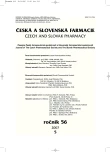Cytochrome P450 3A polymorphism and its importance in cyclosporine and tacrolimus therapy in transplanted patients
Authors:
J. Ďuricová; M. Grundmann
Authors‘ workplace:
Ostravská univerzita, Zdravotně-sociální fakulta, Ústav klinické farmakologie FN, Ostrava
Published in:
Čes. slov. Farm., 2007; 56, 220-224
Category:
Review Articles
Overview
The calcineurin inhibitors cyclosporine (CsA) and tacrolimus (Tac) are widely used in the prevention of acute rejection after solid organ transplantation. However, their clinical use is associated with many adverse reactions. The calcineurin inhibitors CsA and Tac have a narrow therapeutic index and show highly variable pharmacokinetics. The low CsA and Tac bioavailability has been attributed to interindividual differences in the expression of the metabolizing enzyme cytochrome P450 3A. The genes for CYP3A4 and 3A5 undergo genetic polymorphism. The results of many studies focusing on the impact of CYP 3A polymorphism on CsA and Tac pharmacokinetics are clear with Tac, where an association between CYP 3A polymorphism and the pharmacokinetic consequences has been shown. However, the results with CsA are controversial.
Key words:
CYP3A – polymorphism – cyclosporine – tacrolimus – transplantation
Labels
Pharmacy Clinical pharmacologyArticle was published in
Czech and Slovak Pharmacy

2007 Issue 5
Most read in this issue
- Mucoadhesive tablets for oral administration of ciclopiroxolamine
- Cytochrome P450 3A polymorphism and its importance in cyclosporine and tacrolimus therapy in transplanted patients
- Oxidative stress and its role in respiratory diseases
- Determination of valproic acid by on-line coupled capillary isotachophoresis with capillary zone electrophoresis with conductometric detection
